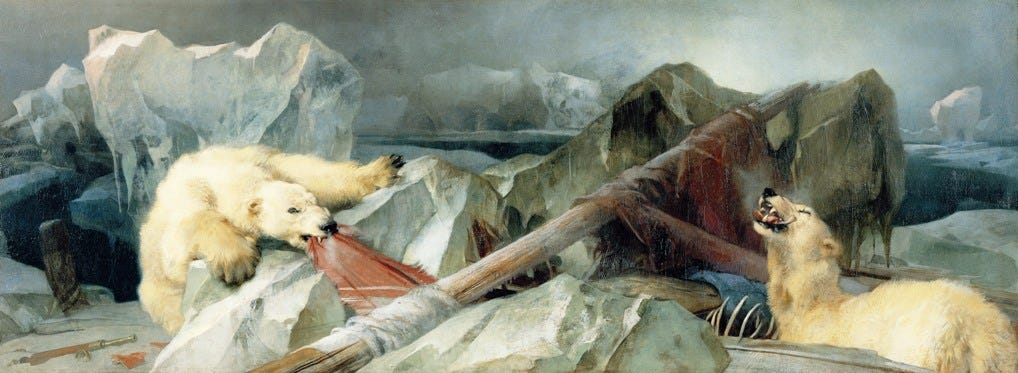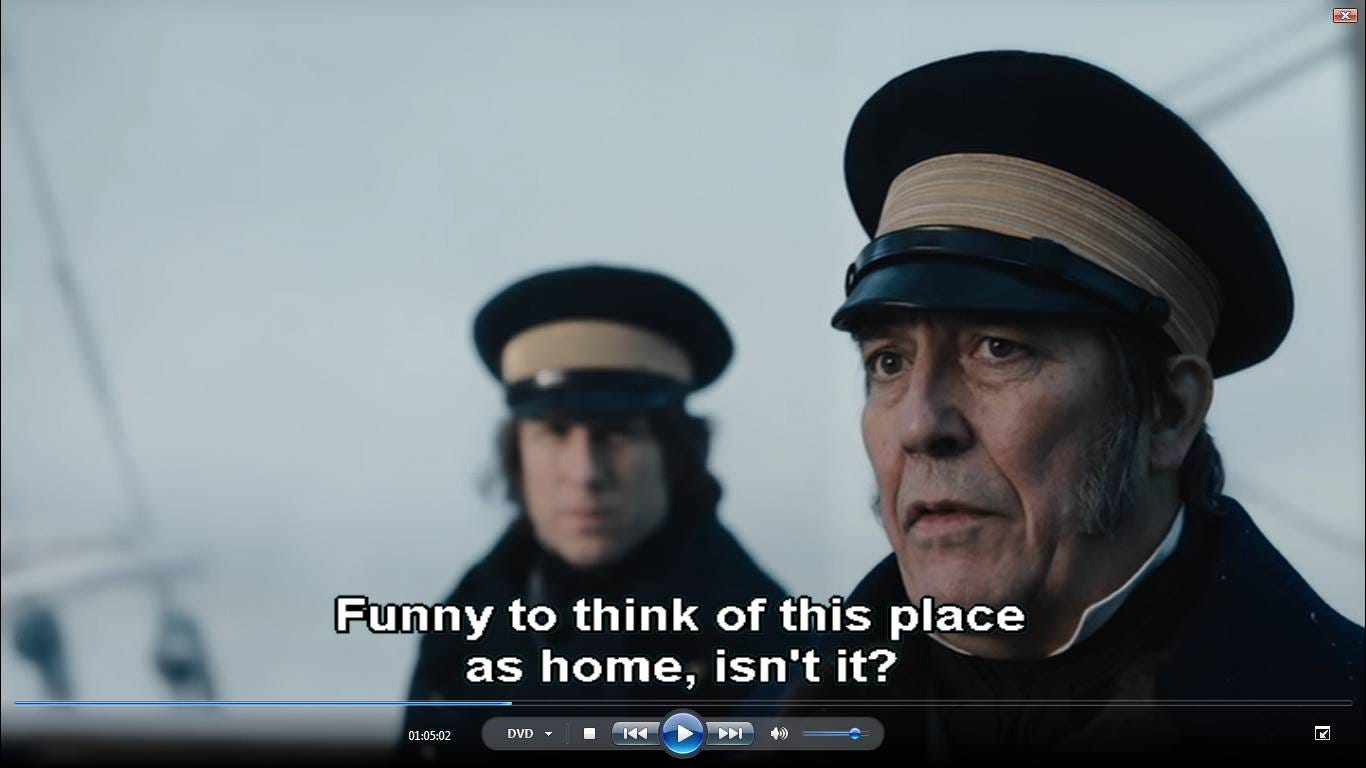I finished Terror the other week, an AMC series about the Franklin expedition in search of the Northwest Passage starring Ciaran Hinds (pictured above), Jared Harris, Tobias Menzies and Greenlandic artist Nive Nielsen. How much drama can you get out of two ships stuck in ice? And Terror comes in 10 episodes. I went in skeptical, particularly after trying and abandoning some of the NWP-inspired fiction, like Dominique Fortier’s romanticizing On the Proper Use of the Stars.
Terror the TV series is based on Dan Simmons’ 2007 horror-fantasy novel by the same name, and from what I can see about it online, the TV version is actually better. In Simmons’ novel some of the principals are clairvoyant, and the Netsilik woman gets assigned the worn-out narrative of a care-giver to one of the captains. The series, developed by American screenwriter David Kajganich and executive-produced by Ridley Scott of Bladerunner fame, is a remarkable accomplishment. Sir John Franklin of HMS Erebus is an arrogant fool who takes a couple of fatally wrong decisions and refuses to reverse them. His second in command, the HMS Terror captain Francis Crozier, more experienced, intelligent, and even fluent in Inuktitut, is an Irishman of lower class pedigree who (the flashback scenes reveal) had asked Franklin’s niece to marry him and was repudiated. Several of the seamen are given storylines, and there’s an ongoing feud between the head doctor and the more hands-on, sympathetic surgeon. The ships get stuck early on and captains decide to sit out the winter and wait for the thaw and the sun to return. The sun returns, without the thaw. At one point the men put all the supplies on rescue boats and set out on foot across the ice toward the arid land.
As if a slow freeze and starvation weren’t enough – and this is the part of the story I was sceptical about – there is a gigantic monster roaming the ice, feeding on humans. It’s gradually revealed that the polar-bear-meets-godzilla was not just there to ratchet up the suspense and gore. In a fit of hallucination, one of the small crew accidentally shoots an old Inuit man, whose daughter (played by Nielsen) then assumes a crucial part in the story. The old man was the shaman who could control the spirit of the roaming Tuunbaq, and without him the monster is on the loose. The series takes some established facts about Inuit spirituality – shamans have been part of Inuit traditions all around the Arctic, in Greenland and Siberia as well – and fictionalizes it. It also heightens the seal hunting: the imagery around cutting and eating raw meat is turned into a shamanic initiation that involves cutting off one’s tongue and giving it as an offering to the Tuunbaq. This appears twice in the series: when the woman is initiated after the death of her father, and near the end, as the cannibalism-prone leader of the rebels presumes the monster will accept him as a shaman.
Two of the three commanding officers are well-connected ciphers who have not even been the Navy’s first (or even second) choice. But they are entitled and careerist, so here they are. The third, Captain Crozier, has a different problem: he is trying to fend off catatonic depression by drinking. Among the crew, there is gay sex (how could it not have been), indications that something may be wrong with the tinned food (the lead poisoning hypothesis gets a fair hearing), and the early stirring of a rebellion. Franklin is gone by episode 4: mauled by the monster in a failed attempt to trap it, his body dumped into the hole in the ice that swallowed the old shaman days before. Back in England, his wife and niece are lobbying and fundraising for a search and rescue mission.
Many many other things happen as horror ratchets up. A band of rebels abandon the spoiled tinned food and turn to cannibalism. This is a highly procedural and on first sight neat pooling of resources, not an anarchic orgy. The good surgeon, Mr Goodsir (actual name of the actual surgeon in the expedition), is now forced to slice the dead comrades for the surviving crew. The rebels eventually capture Captain Crozier, but then suffer collective food poisoning from the last consumed human flesh (I can’t say more) and Crozier escapes and ends up among the Inuit. Time passes, a rescue mission makes it to this particular Esquimaux village, but Crozier decides to remain in hiding. The last scene is a picture of him now as an adopted Inuk, seated next to an ice hole, holding a hakapik and waiting for the seal to emerge. A smiling toddler is next to him, wrapped in fur blanket.
Now, of course, this series would never be made in Canada. The money is American and the cast almost entirely British, with the sole Canadian, Apayata Kotierk of Iglulik, in the silent role of the dying shaman. The distribution is American and British; the show is available on BBC’s iPlayer, on DVD (which is how I got hold of it) and probably, haven’t checked, wherever AMC streams its stuff.
Imagine Kajganch, Ridley Scott et al. pitching this project to Canadian TV producing or art funding bodies. Wait, you propose to write several Inuit characters, rewrite their history and spirituality, introduce a roaming, Inuit-controlled monster? Don’t call us, we’ll call you.
I think the non-First Nations creators in Canada are now flat out avoiding writing the First Nations characters – and our narrative arts are bifurcating into two entities. The desire for separation has reached a fever pitch in the last two years, where people’s entire projects have been shut down if there was any issue raised about the purity of origin of one of the creators (cf the Michelle Latimer and the CBC). Non-Native authors who attempt to write Native characters are likely to be faced with a choice. Either they write-by-committee, i.e. consult and follow the procedures of approval – and that may never be enough or the goalposts may be constantly moving, as the scandal around Angie Abdou’s In Case I Go demonstrated. Or they go it their own way, do their job of a fiction writer, and give all the characters, including the native ones, humanity, complexity, a beating heart.
Terror writers have taken that road. Canadian fiction writers are, it seems to me, opting out of the whole business of writing native characters. Abdou aimed to do almost exactly what Terror writers did: create a world of visions and terrors that both the settler and the indigenous characters experience at the same time as one humanity. From the now-gone blurb about Abdou’s novel: “While Nicholas works long hours at the local coal mine and Lucy battles loneliness and depression, [their son] Eli befriends Mary, a troubled Ktunaxa [First Nation] girl who lives next door. Both children, disturbed by visions of people and places long forgotten, are challenged to account for past lives of seduction and betrayal.”
There have been other attempts to write outside one’s ethnicity and outside the protocols that have ended poorly. Shannon Webb-Campbell and her publisher withdrew an already published book of poetry because, the publisher BookHug says, it “failed to follow Indigenous protocols” of fictionalization. That Webb-Campbell’s was a collection of poems intended to raise awareness about the missing and murdered indigenous women did not matter. She wrote an Inuk character without permission, and that was the end of that.
Andre Alexis published an essay in 2017 in which he, extremely cautiously, wonders if “we devised an idea – ‘cultural appropriation’ – that runs the risk of hiding Indigenous Canadian culture, not preserving it”.
I'm a writer of fiction who is obsessed with the idea of place. In the novel I'm currently writing, I have tried to give voice to the Canadian forest – well, Ontario scrub, anyway. Naturally, I wondered if I had the right to use the names of Indigenous gods in my work. It seemed to me that the land I love had been travelled – its mysteries named – hundreds of years before me, that at some point an Indigenous artist had looked on a (cleaner, less cemented) version of our landscape and listened for its voice. Why should I have to refer to Judeo-Christian gods or Greek gods – gods who are strange to my land – when speaking of the holy? Do I have the right to speak the sacred names of those whose names are part of the language I speak – Toronto, Ottawa, Saskatchewan. Our most beautiful names come from those who've been here longest.
I decided not to use the names and gods because, in the end, I wasn't at ease with them. Certainly I was less familiar with them than I am with the Greek pantheon, say. The culture of the people who first named the land isn't taught to me. I don't know their religions. I wish I did know them. I wish I had been taught them.
Well. The creators of Terror did the opposite: read their history and anthropology, yes, but then just went all in and created something that engages in a new way with the ideas of the North, shamanism, civilization, hubris, what we share and what divides us. And it’s a story of humans, not a story of irreconcilable races.
There’s an scene in one of the early episodes where Franklin is observing his sailors in a game of soccer on the ice and saying to no one in particular, Funny to think of this place as home, isn’t it? So Terror is in a roundabout way about Canada too. A home for all kinds of incongruous people, some who will be extremely different from the other. Are we abandoning that idea, are we going to be staying in our self-designated lanes? If Canadian fiction does, it’ll be the end of it. When it’s finally gone, we can turn full-time and with no qualms to American and British fiction, which will be robust, bolshy and entertaining.
Till next Monday -
LP





